The Role Of Automatic Pool Cleaners In Simplifying Pool Care
Maintaining a pool can be as stressful as it is enjoyable. The shimmering blue water, the refreshing swim on a hot day—these rewards often come at the cost of countless hours spent scrubbing, vacuuming, and balancing chemicals. For many pool owners, the routine can feel like an uphill battle. But what if there was a way to keep your pool sparkling clean with minimal effort? Enter the world of automatic pool cleaners. In this blog post, we'll explore how these innovative devices can simplify your pool care routine, making it easier to enjoy your oasis without the hassle.
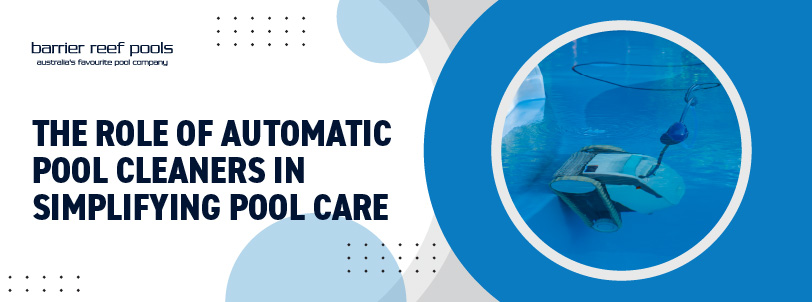
The Challenges of Traditional Pool Maintenance
Owning a pool is a luxury, but maintaining it can be a chore. From skimming leaves to vacuuming debris and scrubbing algae off the walls, traditional pool maintenance demands time and effort. Not to mention the chemical balancing act that ensures the water is safe for swimming. Many pool owners find themselves overwhelmed by these tasks, especially during peak swimming seasons.
Time-Consuming and Labour-Intensive
Traditional methods of pool cleaning are notoriously time-consuming. Skimming the surface for leaves and debris is a daily task that can take up a significant portion of your time. Manually vacuuming the pool can be even more laborious, requiring physical effort and meticulous attention to detail to ensure every corner is clean.
Chemical Balance and Water Quality
Maintaining the chemical balance of your pool water is crucial for safe swimming conditions. Incorrect chemical levels can lead to cloudy water, skin irritation, and even damage to your pool equipment. Regular testing and adjustment of chlorine, pH, and alkalinity levels are necessary but can be confusing and time-consuming for many pool owners.
The Importance of Regular Maintenance
Neglecting your pool, even for a short period, can lead to bigger problems, such as algae growth and clogged filters. Regular maintenance ensures that your pool stays clean, safe, and inviting. However, the effort required often discourages consistent upkeep, leading to a cycle of neglect and intensive cleaning sessions.
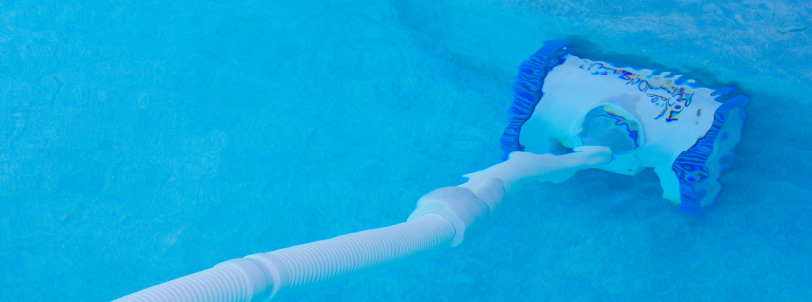
Understanding Automatic Pool Cleaners
Automatic pool cleaners are a revolutionary solution designed to take the hassle out of pool maintenance. These devices operate independently to keep your pool clean, allowing you to spend more time enjoying your pool rather than maintaining it.
Types of Automatic Pool Cleaners
There are three main types of automatic pool cleaners, each with its unique features and benefits:
- Suction-Side Cleaners: These cleaners attach to your pool’s existing filtration system and use the suction generated by the pump to move around the pool and vacuum debris.
- Pressure-Side Cleaners: These devices connect to a dedicated return line or booster pump, using water pressure to propel themselves around the pool while collecting debris in an attached bag.
- Robotic Cleaners: The most advanced type, robotic cleaners operate independently of your pool’s filtration system. They are powered by electricity and come equipped with their filters and brushes, offering superior cleaning capabilities.
How Automatic Pool Cleaners Work
Automatic pool cleaners are designed to navigate your pool, collecting debris and scrubbing surfaces without manual intervention. Suction-side and pressure-side cleaners rely on your pool’s pump and filtration system, while robotic cleaners have their motors and filters. These devices use advanced technology to map out the pool’s surface, ensuring comprehensive coverage and efficient cleaning.
Benefits of Automatic Pool Cleaners
The advantages of automatic pool cleaners extend beyond just saving time and effort:
- Consistent Cleanliness: Automatic cleaners maintain a high level of cleanliness, reducing the likelihood of algae growth and other issues.
- Energy Efficiency: Robotic cleaners are energy-efficient, using less power compared to traditional cleaning methods.
- Extended Equipment Life: By keeping your pool consistently clean, automatic cleaners help extend the life of your pool equipment, reducing the need for repairs and replacements.
Choosing the Right Automatic Pool Cleaner
Selecting the best automatic pool cleaner for your needs involves considering various factors, including your pool’s type, size, and your budget. Here’s a guide to help you make an informed decision.
Pool Type and Size
Different pool types and sizes require different cleaning solutions. For example:
- In-ground Pools: Robotic cleaners are often the best choice for in-ground pools due to their advanced cleaning capabilities and ability to handle large areas.
- Above-ground Pools: Suction-side cleaners are typically more suitable for above-ground pools, offering effective cleaning at a lower cost.
- Large Pools: Pressure-side and robotic cleaners are ideal for larger pools, providing thorough cleaning over extensive areas.
Budget Considerations
Automatic pool cleaners come in a range of prices, from affordable suction-side cleaners to high-end robotic models. Consider your budget when making a choice, and remember that investing in a quality cleaner can save you money in the long run by reducing maintenance costs and extending the life of your pool equipment.
Specific Cleaning Needs
Identify any specific cleaning needs your pool may have. For instance, if your pool is surrounded by trees and collects a lot of leaves, a pressure-side cleaner with a large debris bag might be the best option. If your pool has a lot of fine dirt and sand, a robotic cleaner with fine filtration capabilities could be more effective.

Installation and Maintenance Tips
Once you’ve chosen the right automatic pool cleaner, proper installation and maintenance are crucial to ensure optimal performance and longevity.
Installation Best Practices
Follow these steps for a smooth installation process:
- Read the Manual: Always start by reading the manufacturer’s instructions to understand the specific requirements of your cleaner.
- Check Compatibility: Ensure that the cleaner is compatible with your pool’s filtration system and that all necessary connections are secure.
- Prime the Cleaner: For suction-side and pressure-side cleaners, prime the cleaner by filling it with water before connecting it to the pool. This helps prevent airlocks and ensures smooth operation.
Regular Maintenance
To keep your automatic pool cleaner running efficiently, follow these maintenance tips:
- Clean the Filters: Regularly clean or replace the filters in your cleaner to prevent clogging and maintain suction power.
- Inspect Moving Parts: Periodically check the brushes, wheels, and other moving parts for wear and tear. Replace any worn-out components to ensure optimal cleaning performance.
- Store Properly: When not in use, store your cleaner in a cool, dry place away from direct sunlight to prevent damage and prolong its lifespan.
Troubleshooting Common Issues
If your cleaner encounters problems, try these troubleshooting tips:
- Low Suction: Check for obstructions in the hoses or filters and ensure that the pump and filtration system are functioning correctly.
- Stuck Cleaner: If the cleaner gets stuck in one area, adjust the hose length or add a swivel attachment to improve mobility.
- Poor Cleaning Performance: Inspect the brushes and filters for debris build-up and clean them as needed. Ensure that the cleaner is properly balanced and not tilting to one side.
Conclusion
Automatic pool cleaners are a game-changer for pool owners, simplifying the maintenance process and allowing you to enjoy your pool more. By choosing the right cleaner and following best practices for installation and maintenance, you can keep your pool sparkling clean with minimal effort.
The Role Of Automatic Pool Cleaners In Simplifying Pool Care
Maintaining a pool can be as stressful as it is enjoyable. The shimmering blue water, the refreshing swim on a hot day—these rewards often come at the cost of countless hours spent scrubbing, vacuuming, and balancing chemicals. For many pool owners, the routine can feel like an uphill battle. But what if there was a way to keep your pool sparkling clean with minimal effort? Enter the world of automatic pool cleaners. In this blog post, we'll explore how these innovative devices can simplify your pool care routine, making it easier to enjoy your oasis without the hassle.
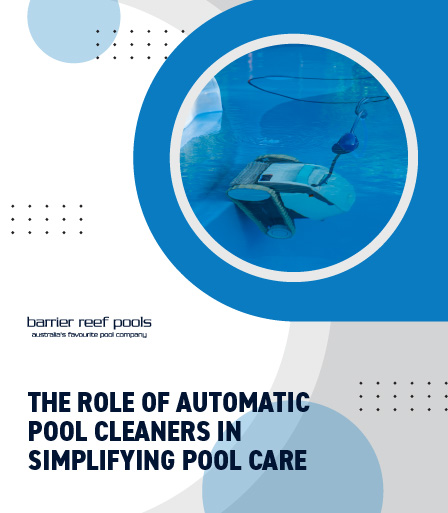
The Challenges of Traditional Pool Maintenance
Owning a pool is a luxury, but maintaining it can be a chore. From skimming leaves to vacuuming debris and scrubbing algae off the walls, traditional pool maintenance demands time and effort. Not to mention the chemical balancing act that ensures the water is safe for swimming. Many pool owners find themselves overwhelmed by these tasks, especially during peak swimming seasons.
Time-Consuming and Labour-Intensive
Traditional methods of pool cleaning are notoriously time-consuming. Skimming the surface for leaves and debris is a daily task that can take up a significant portion of your time. Manually vacuuming the pool can be even more laborious, requiring physical effort and meticulous attention to detail to ensure every corner is clean.
Chemical Balance and Water Quality
Maintaining the chemical balance of your pool water is crucial for safe swimming conditions. Incorrect chemical levels can lead to cloudy water, skin irritation, and even damage to your pool equipment. Regular testing and adjustment of chlorine, pH, and alkalinity levels are necessary but can be confusing and time-consuming for many pool owners.
The Importance of Regular Maintenance
Neglecting your pool, even for a short period, can lead to bigger problems, such as algae growth and clogged filters. Regular maintenance ensures that your pool stays clean, safe, and inviting. However, the effort required often discourages consistent upkeep, leading to a cycle of neglect and intensive cleaning sessions.
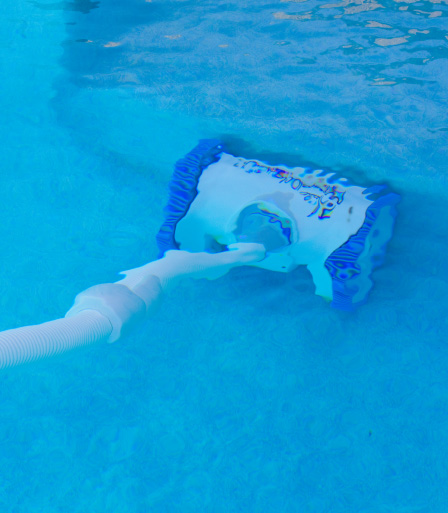
Understanding Automatic Pool Cleaners
Automatic pool cleaners are a revolutionary solution designed to take the hassle out of pool maintenance. These devices operate independently to keep your pool clean, allowing you to spend more time enjoying your pool rather than maintaining it.
Types of Automatic Pool Cleaners
There are three main types of automatic pool cleaners, each with its unique features and benefits:
- Suction-Side Cleaners: These cleaners attach to your pool’s existing filtration system and use the suction generated by the pump to move around the pool and vacuum debris.
- Pressure-Side Cleaners: These devices connect to a dedicated return line or booster pump, using water pressure to propel themselves around the pool while collecting debris in an attached bag.
- Robotic Cleaners: The most advanced type, robotic cleaners operate independently of your pool’s filtration system. They are powered by electricity and come equipped with their filters and brushes, offering superior cleaning capabilities.
How Automatic Pool Cleaners Work
Automatic pool cleaners are designed to navigate your pool, collecting debris and scrubbing surfaces without manual intervention. Suction-side and pressure-side cleaners rely on your pool’s pump and filtration system, while robotic cleaners have their motors and filters. These devices use advanced technology to map out the pool’s surface, ensuring comprehensive coverage and efficient cleaning.
Benefits of Automatic Pool Cleaners
The advantages of automatic pool cleaners extend beyond just saving time and effort:
- Consistent Cleanliness: Automatic cleaners maintain a high level of cleanliness, reducing the likelihood of algae growth and other issues.
- Energy Efficiency: Robotic cleaners are energy-efficient, using less power compared to traditional cleaning methods.
- Extended Equipment Life: By keeping your pool consistently clean, automatic cleaners help extend the life of your pool equipment, reducing the need for repairs and replacements.
Choosing the Right Automatic Pool Cleaner
Selecting the best automatic pool cleaner for your needs involves considering various factors, including your pool’s type, size, and your budget. Here’s a guide to help you make an informed decision.
Pool Type and Size
Different pool types and sizes require different cleaning solutions. For example:
- In-ground Pools: Robotic cleaners are often the best choice for in-ground pools due to their advanced cleaning capabilities and ability to handle large areas.
- Above-ground Pools: Suction-side cleaners are typically more suitable for above-ground pools, offering effective cleaning at a lower cost.
- Large Pools: Pressure-side and robotic cleaners are ideal for larger pools, providing thorough cleaning over extensive areas.
Budget Considerations
Automatic pool cleaners come in a range of prices, from affordable suction-side cleaners to high-end robotic models. Consider your budget when making a choice, and remember that investing in a quality cleaner can save you money in the long run by reducing maintenance costs and extending the life of your pool equipment.
Specific Cleaning Needs
Identify any specific cleaning needs your pool may have. For instance, if your pool is surrounded by trees and collects a lot of leaves, a pressure-side cleaner with a large debris bag might be the best option. If your pool has a lot of fine dirt and sand, a robotic cleaner with fine filtration capabilities could be more effective.
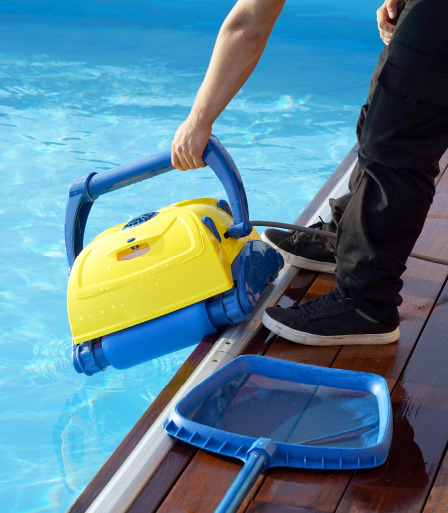
Installation and Maintenance Tips
Once you’ve chosen the right automatic pool cleaner, proper installation and maintenance are crucial to ensure optimal performance and longevity.
Installation Best Practices
Follow these steps for a smooth installation process:
- Read the Manual: Always start by reading the manufacturer’s instructions to understand the specific requirements of your cleaner.
- Check Compatibility: Ensure that the cleaner is compatible with your pool’s filtration system and that all necessary connections are secure.
- Prime the Cleaner: For suction-side and pressure-side cleaners, prime the cleaner by filling it with water before connecting it to the pool. This helps prevent airlocks and ensures smooth operation.
Regular Maintenance
To keep your automatic pool cleaner running efficiently, follow these maintenance tips:
- Clean the Filters: Regularly clean or replace the filters in your cleaner to prevent clogging and maintain suction power.
- Inspect Moving Parts: Periodically check the brushes, wheels, and other moving parts for wear and tear. Replace any worn-out components to ensure optimal cleaning performance.
- Store Properly: When not in use, store your cleaner in a cool, dry place away from direct sunlight to prevent damage and prolong its lifespan.
Troubleshooting Common Issues
If your cleaner encounters problems, try these troubleshooting tips:
- Low Suction: Check for obstructions in the hoses or filters and ensure that the pump and filtration system are functioning correctly.
- Stuck Cleaner: If the cleaner gets stuck in one area, adjust the hose length or add a swivel attachment to improve mobility.
- Poor Cleaning Performance: Inspect the brushes and filters for debris build-up and clean them as needed. Ensure that the cleaner is properly balanced and not tilting to one side.
Conclusion
Automatic pool cleaners are a game-changer for pool owners, simplifying the maintenance process and allowing you to enjoy your pool more. By choosing the right cleaner and following best practices for installation and maintenance, you can keep your pool sparkling clean with minimal effort.


